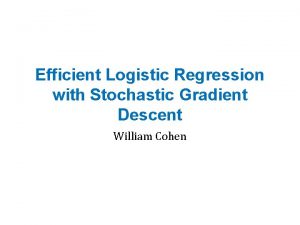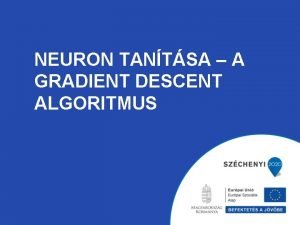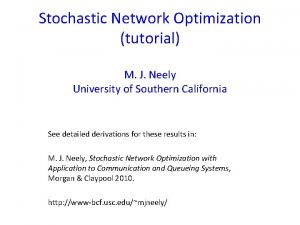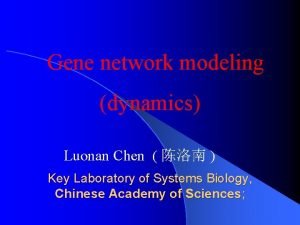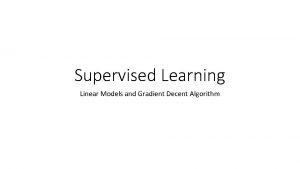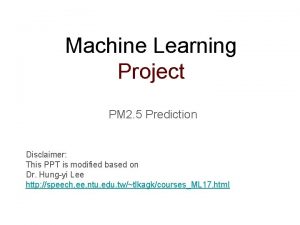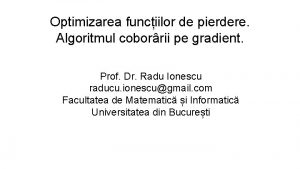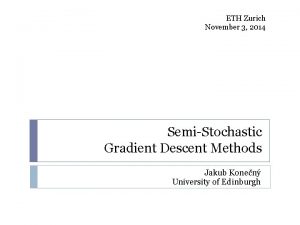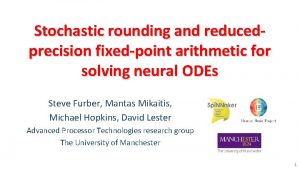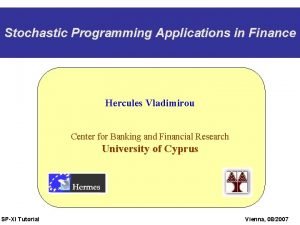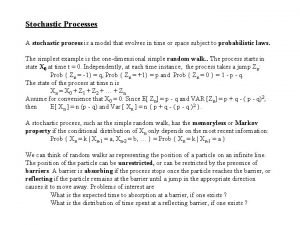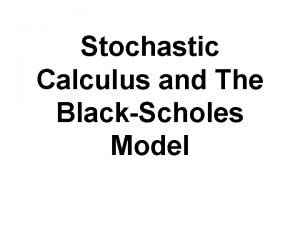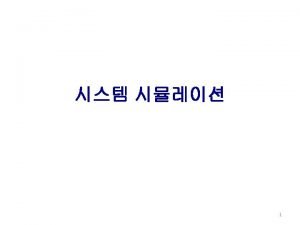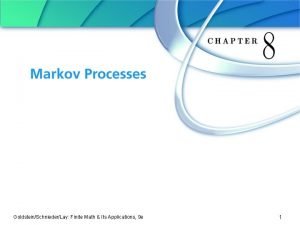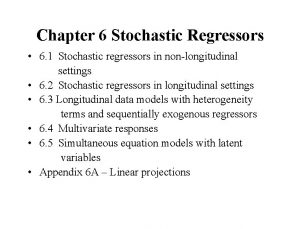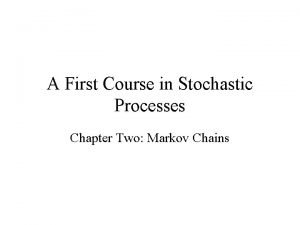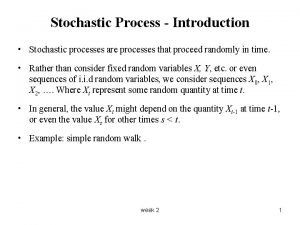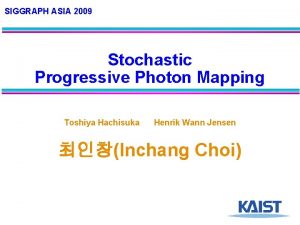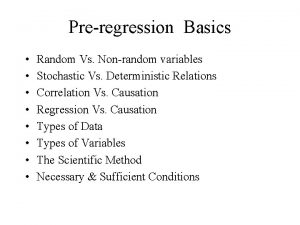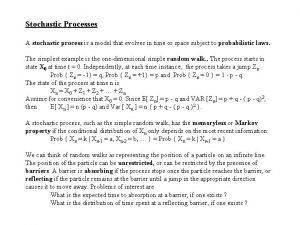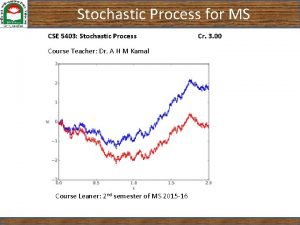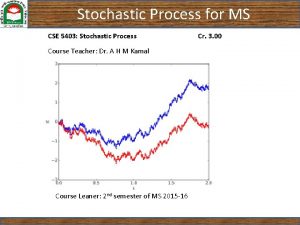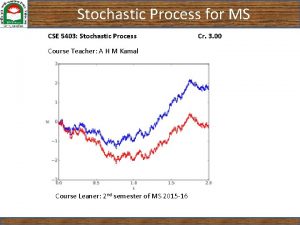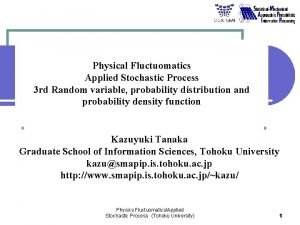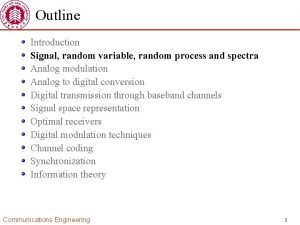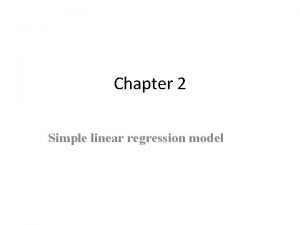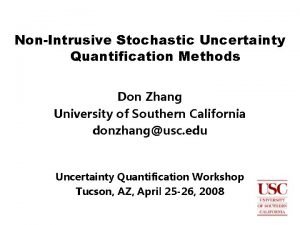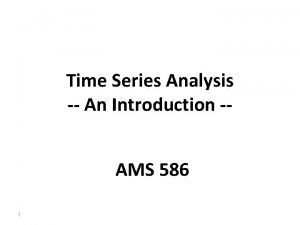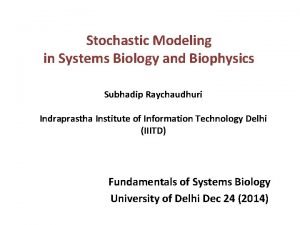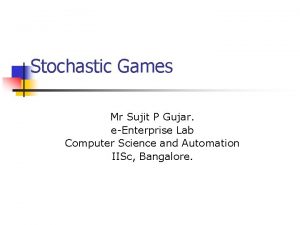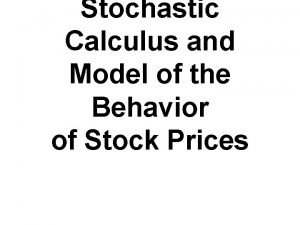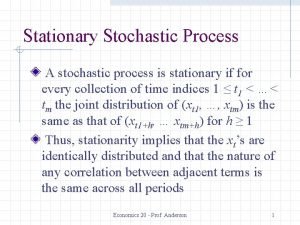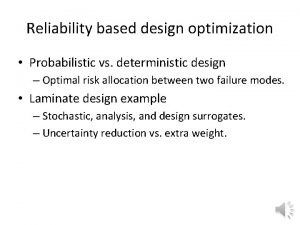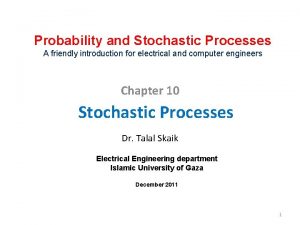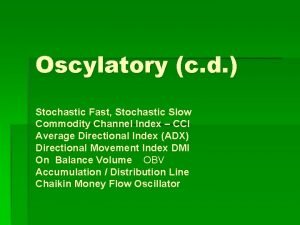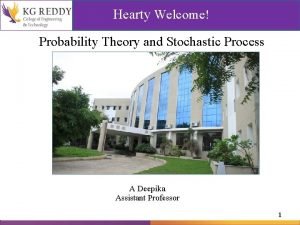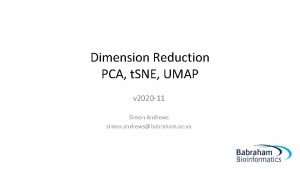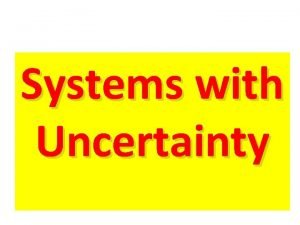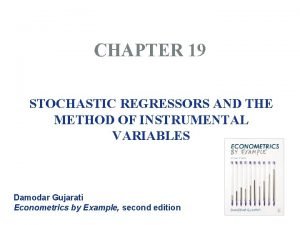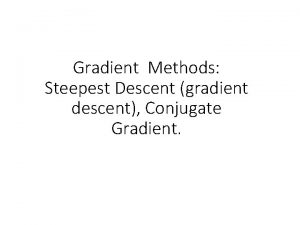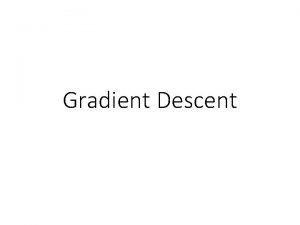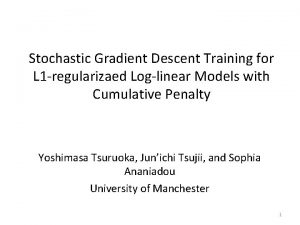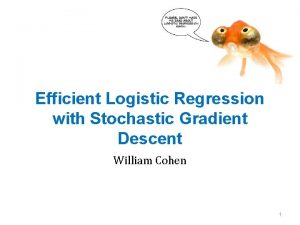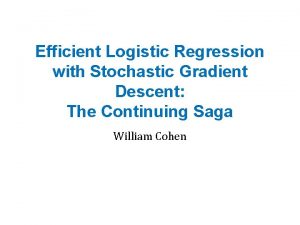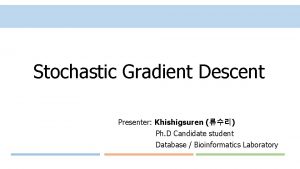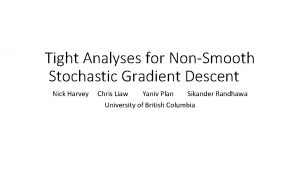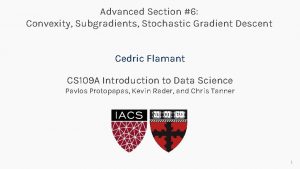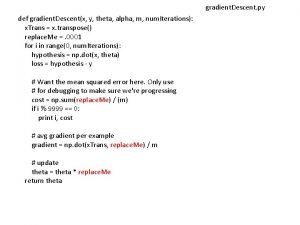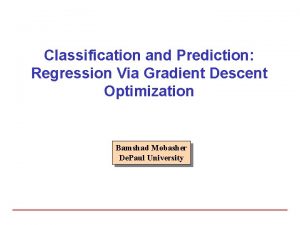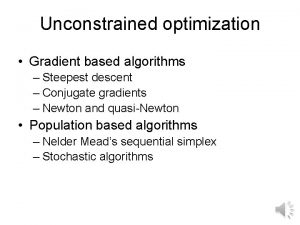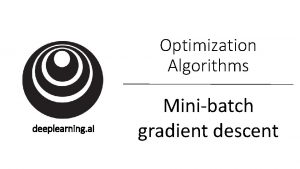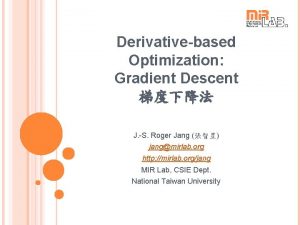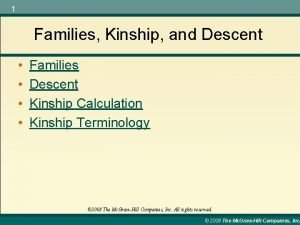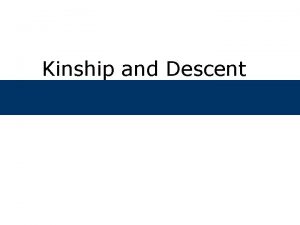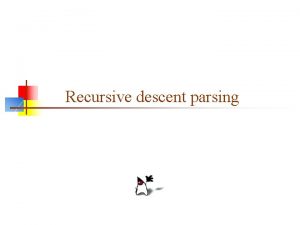Training and optimization Stochastic gradient descent Gradient on














































- Slides: 46

Training and optimization

Stochastic gradient descent • Gradient on single example = unbiased sample of true gradient • Idea: at each iteration sample single example x(t) step size • Con: variance in estimate of gradient slow convergence, jumping near optimum

Minibatch stochastic gradient descent • Compute gradient on a small batch of examples • Same mean (=true gradient), but variance inversely proportional to minibatch size

Momentum • Average multiple gradient steps • Use exponential averaging

Weight decay • Add -aw(t) to the gradient • Prevents w(t) from growing to infinity • Equivalent to L 2 regularization of weights

Learning rate decay • Large step size / learning rate • Faster convergence initially • Bouncing around at the end because of noisy gradients • Learning rate must be decreased over time • Usually done in steps

Convolutional network training • Initialize network • Sample minibatch of images • Forward pass to compute loss • Backpropagate loss to compute gradient • Combine gradient with momentum and weight decay • Take step according to current learning rate

Beyond sequences: computation graphs • Multi-layer perceptrons and first convolutional networks were sequences of functions • In general, can have arbitrary DAGs of functions u g k x l f y h w

Computation graphs • Each node implements two methods • A “forward” • Computes output given input • A “backward” • Computes derivative of z w. r. t input, given derivative of z w. r. t output

Computation graphs a b c fi d

Computation graphs fi

Exploring convnet architectures

Deeper is better Challenge winner's accuracy 30 25 7 layers 20 15 16 layers 10 5 0 2011 2012 2013 2014

Deeper is better Challenge winner's accuracy 30 25 Alexnet 20 15 VGG 16 10 5 0 2011 2012 2013 2014

The VGG pattern • Every convolution is 3 x 3, padded by 1 • Every convolution followed by Re. LU • Conv. Net is divided into “stages” • Layers within a stage: no subsampling • Subsampling by 2 at the end of each stage • Layers within stage have same number of channels • Every subsampling double the number of channels

Challenges in training: exploding / vanishing gradients • Vanishing / exploding gradients • If each term is (much) greater than 1 explosion of gradients • If each term is (much) less than 1 vanishing gradients

Challenges in training: dependence on init

Solutions • Careful init • Batch normalization • Residual connections

Careful initialization • Key idea: want variance to remain approx. constant • Variance increases in backward pass => exploding gradient • Variance decreases in backward pass => vanishing gradient • “MSRA initialization” • weights = Gaussian with 0 mean and variance = 2/(k*k*d) Delving Deep into Rectifiers: Surpassing Human-Level Performance on Image. Net Classification. K. He, X. Zhang, S. Ren, J. Sun

Batch normalization • Key idea: normalize so that each layer output has zero mean and unit variance • Compute mean and variance for each channel • Aggregate over batch • Subtract mean, divide by std • Need to reconcile train and test • No ”batches” during test • After training, compute means and variances on train set and store Batch Normalization: Accelerating Deep Network Training by Reducing Internal Covariate Shift. S. Ioffe, C. Szegedy. In ICML, 2015.

Residual connections • In general, gradients tend to vanish • Key idea: allow gradients to flow unimpeded

Residual connections • In general, gradients tend to vanish • Key idea: allow gradients to flow unimpeded

Residual connections • Assumes all zi have the same size • True within a stage • Across stages? • Doubling of feature channels • Subsampling • Increase channels by 1 x 1 convolution • Decrease spatial resolution by subsampling

A residual block • Instead of single layers, have residual connections over block Conv BN Re. LU Conv BN

Bottleneck blocks •

The Res. Net pattern • Decrease resolution substantially in first layer • Reduces memory consumption due to intermediate outputs • Divide into stages • maintain resolution, channels in each stage • halve resolution, double channels between stages • Divide each stage into residual blocks • At the end, compute average value of each channel to feed linear classifier

Putting it all together - Residual networks Challenge winner's accuracy 30 200 25 150 20 15 100 10 50 5 0 0 2011 2012 2013 2014 2015

Computational complexity

Analyzing computational complexity •

Reducing computational complexity • …while maintaining accuracy? • Multiple ways: • Make architecture a priori cheaper • Make weights and operations cheaper • Make inference adaptive

Cheaper convolutional blocks •

Cheaper convolutional blocks •

Grouped and depth-wise convolutions Xie, Saining, et al. "Aggregated residual transformations for deep neural networks. " Proceedings of the IEEE conference on computer vision and pattern recognition. 2017. Howard, Andrew G. , et al. "Mobilenets: Efficient convolutional neural networks for mobile vision applications. " ar. Xiv preprint ar. Xiv: 1704. 04861 (2017).

Other architectural changes • Biggest memory consumption: large feature maps Expensive feature maps VGG 19 Image

Other architectural changes • Biggest memory consumption: large feature maps • Simple solution: reduce resolution early

Other architectural changes • Biggest memory consumption: large feature maps • Simple solution (Res. Net): • Reduce resolution drastically (/4) early • More sophisticated changes: Inverted residuals (Mobile. Net v 2) Sandler, Mark, et al. "Mobilenetv 2: Inverted residuals and linear bottlenecks. " Proceedings of the IEEE Conference on Computer Vision and Pattern Recognition. 2018. Dispose of these

Other kinds of connections • Dense. Nets • Replace addition of residuals with concatenation • Alternative to solving vanishing gradient problem • Should increase number of parameters, but decreases them • Better re-use of features

Adaptive inference • Some examples are harder than others • Should be able to use different amounts of computation for different examples • Version 1: skip some residuals Veit, Andreas, and Serge Belongie. "Convolutional networks with adaptive inference graphs. " Proceedings of the European Conference on Computer Vision (ECCV). 2018. Wu, Zuxuan, et al. "Blockdrop: Dynamic inference paths in residual networks. " Proceedings of the IEEE Conference on Computer Vision and Pattern Recognition. 2018.

Adaptive inference • Some examples are harder than others • Should be able to use different amounts of computation for different examples • Version 1: skip some residuals Veit, Andreas, and Serge Belongie. "Convolutional networks with adaptive inference graphs. " Proceedings of the European Conference on Computer Vision (ECCV). 2018. Wu, Zuxuan, et al. "Blockdrop: Dynamic inference paths in residual networks. " Proceedings of the IEEE Conference on Computer Vision and Pattern Recognition. 2018.

Adaptive inference • Some examples are harder than others • Should be able to use different amounts of computation for different examples • Version 2: reduce resolution at different rates Huang, Gao, et al. "Multi-scale dense networks for resource efficient image classification. " ICLR 2018

Compressing model weights • All of model storage: filters • Flops also scale with non-zero entries in filters (in principle) • Compress filters • Sparsify them • Represent them with fewer bits

Pruning network connections • Simple approach: prune weights that are below a threshold • Retrain rest of the weights • Repeat Han, Song, Huizi Mao, and William J. Dally. "Deep compression: Compressing deep neural networks with pruning, trained quantization and huffman coding. " ICLR, 2016

Pruning network connections • Simple approach: prune weights that are below a threshold • Retrain rest of the weights • Repeat • Sophisticated alternative • Train with regularizer that penalizes expensive connections • Prune • If model within budget, expand retrain Gordon, Ariel, et al. "Morphnet: Fast & simple resource-constrained structure learning of deep networks. " Proceedings of the IEEE Conference on Computer Vision and Pattern Recognition. 2018.

Filter quantization • Two questions: • How do we quantize? • Quantization discrete values. How do we optimize? • Example 1: cluster • Weights indices into dictionary • Update dictionary elements as parameters. Han, Song, Huizi Mao, and William J. Dally. "Deep compression: Compressing deep neural networks with pruning, trained quantization and huffman coding. " ICLR, 2016

Filter quantization • Two questions: • How do we quantize? • Quantization discrete values. How do we optimize? • Example 2: binarize/ternarize • Weights binary/ternary, + real-valued scale • Parameter updates happen in real space Zhu, Chenzhuo, et al. "Trained ternary quantization. " ICLR, 2017. Rastegari, Mohammad, et al. "Xnor-net: Imagenet classification using binary convolutional neural networks. " European Conference on Computer Vision. Springer, Cham, 2016.

 Logistic regression stochastic gradient descent
Logistic regression stochastic gradient descent Gradient descent
Gradient descent Divbar
Divbar Stochastic gradient langevin dynamics
Stochastic gradient langevin dynamics Gradient descent equation
Gradient descent equation Linear regression with multiple features
Linear regression with multiple features Linear regression gradient descent
Linear regression gradient descent Batch gradient descent
Batch gradient descent Batch gradient descent
Batch gradient descent Gradient descent python implementation
Gradient descent python implementation Gradient descent rule
Gradient descent rule Deterministic demand vs stochastic demand
Deterministic demand vs stochastic demand Deterministic and stochastic inventory models
Deterministic and stochastic inventory models Stochastic rounding
Stochastic rounding Stochastic programming
Stochastic programming Stochastic process model
Stochastic process model Black schoels
Black schoels Stochastic vs dynamic
Stochastic vs dynamic Absorbing stochastic matrix
Absorbing stochastic matrix Stochastic regressors
Stochastic regressors Non stochastic theory of aging
Non stochastic theory of aging A first course in stochastic processes
A first course in stochastic processes Stochastic process introduction
Stochastic process introduction Stochastic progressive photon mapping
Stochastic progressive photon mapping Agent a chapter 2
Agent a chapter 2 Non stochastic variable
Non stochastic variable Stochastic process modeling
Stochastic process modeling Stochastic process
Stochastic process Stochastic process
Stochastic process Stochastic process
Stochastic process Stochastic process
Stochastic process Stochastic processes
Stochastic processes Guided, stochastic model-based gui testing of android apps
Guided, stochastic model-based gui testing of android apps Srf in econometrics
Srf in econometrics Stochastic uncertainty
Stochastic uncertainty Time series components
Time series components Stochastic vs probabilistic
Stochastic vs probabilistic Stochastic vs probabilistic
Stochastic vs probabilistic Stochastic calculus
Stochastic calculus Stationary stochastic process
Stationary stochastic process Stochastic vs probabilistic
Stochastic vs probabilistic Introduction to stochastic processes pdf
Introduction to stochastic processes pdf Stochastic slow
Stochastic slow Stochastic processes
Stochastic processes Pca example
Pca example Stochastic rounding
Stochastic rounding Stochastic regressors
Stochastic regressors
